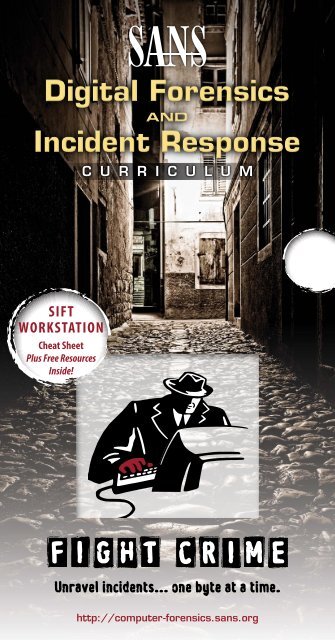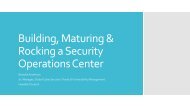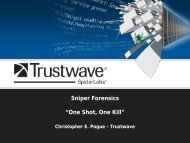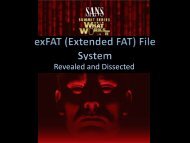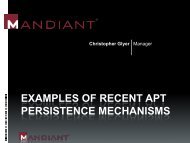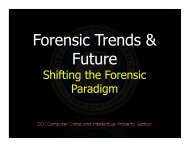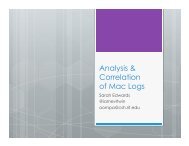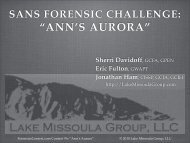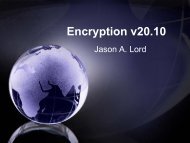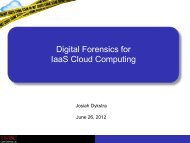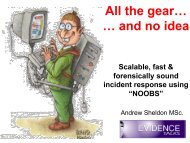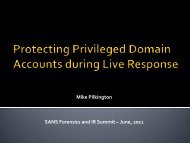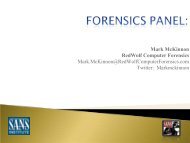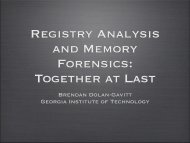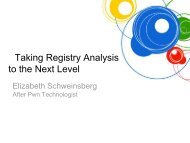SIFT WORKSTATION - SANS Computer Forensics - SANS Institute
SIFT WORKSTATION - SANS Computer Forensics - SANS Institute
SIFT WORKSTATION - SANS Computer Forensics - SANS Institute
You also want an ePaper? Increase the reach of your titles
YUMPU automatically turns print PDFs into web optimized ePapers that Google loves.
<strong>SIFT</strong><br />
<strong>WORKSTATION</strong><br />
Cheat Sheet<br />
Plus Free Resources<br />
Inside!<br />
C U R R I C U L U M<br />
http://computer-forensics.sans.org
<strong>SANS</strong> <strong>Forensics</strong> Curriculum<br />
<strong>SANS</strong> forensics line-up features courses both for those who are new to<br />
the eld as well as for seasoned professionals. Come learn from true<br />
industry experts and experience forensics in a hands-on, immersion<br />
style environment. By the time you complete a course, you will be<br />
able to put your knowledge to work when you get back to the oce.<br />
FOR558<br />
Network<br />
<strong>Forensics</strong><br />
FOR408<br />
<strong>Computer</strong> Forensic<br />
Investigations –<br />
Windows In-Depth<br />
GCFE<br />
FOR508<br />
Advanced <strong>Computer</strong><br />
Forensic Analysis &<br />
Incident Response<br />
GCFA<br />
FOR610<br />
REM: Malware<br />
Analysis Tools &<br />
Techniques<br />
GREM<br />
Additional <strong>Forensics</strong> Courses<br />
FOR526<br />
Windows<br />
Memory <strong>Forensics</strong><br />
In-Depth<br />
Not sure which course to take?<br />
Try our free online assessment at<br />
http://computer-forensics.sans.org/courses/assessment<br />
http://computer-forensics.sans.org<br />
FOR563<br />
Mobile Device<br />
<strong>Forensics</strong><br />
Fight Crime. Unravel Incidents one byte at a time.
Dear Colleague,<br />
Over the past year, digital crime has increased. This clearly<br />
indicates that criminal and hacking groups are racking up<br />
success after success. Organized crime groups utilizing botnets<br />
are exploiting ACH fraud daily. Similar groups are penetrating<br />
banks and merchants stealing credit card data. Fortune 500<br />
companies are beginning to detail data breaches and hacks in<br />
their annual stockholders reports.<br />
The adversaries are getting better, bolder, and their success rate<br />
is impressive, but are we as cyber crime ghters able to keep up?<br />
Rob Lee<br />
Bottom line, we can do better. We need to develop a eld full of sophisticated<br />
incident responders and forensic investigators. We need lethal forensicators<br />
that can detect and eradicate advanced threats immediately. A properly trained<br />
incident responder could be the only defense your organization has during<br />
a compromise. As a forensic investigator, you need to know what you are up<br />
against. You need to know what the seasoned experts in the eld know. You<br />
need to stay ahead, constantly seeking new knowledge and experience, and<br />
that’s what <strong>SANS</strong> courses will teach you.<br />
The <strong>SANS</strong> Digital <strong>Forensics</strong> Curriculum brings together top professionals that<br />
have developed the industry’s leading innovative courses for digital forensics<br />
and in-depth specialty training. My goal is to continue to oer the most<br />
rewarding training to each individual. We will arm you with the tools to ght<br />
crime and solve complex digital forensic cases the day after you leave class. I<br />
aim to push each investigator’s knowledge with advanced skills and techniques<br />
to help successfully investigate and defend organizations from sophisticated<br />
attacks.<br />
Finally, listed in this catalog are resources to help you stay abreast of the ongoing<br />
changes to the industry, recent tool releases, and new research. We have<br />
over 70 authors that contribute to the <strong>SANS</strong> Digital <strong>Forensics</strong> Blog, so check it<br />
often for the latest digital forensics information. We have released the popular<br />
<strong>SIFT</strong> Workstation as a free download available on the <strong>SANS</strong> <strong>Forensics</strong> website<br />
computer-forensics.sans.org. Our aim is to provide not only the best training,<br />
but also community resources for this growing eld.<br />
Looking forward to seeing you at our conferences and training events.<br />
Best regards,<br />
Rob Lee<br />
<strong>SANS</strong> Faculty Fellow<br />
CONTENTS<br />
FOR408 <strong>Computer</strong> Forensic Investigations – Windows In-Depth . . . . . . . . . . . . . . 2<br />
FOR508 Advanced <strong>Computer</strong> Forensic Analysis and Incident Response . . . . . . . 4<br />
FOR558 Network <strong>Forensics</strong> . . . . . . . . . . . . . . . . . . . . . . . . . . . . . . . . . . . . . . . . . . . . . . . . 6<br />
FOR563 Mobile Device <strong>Forensics</strong>. . . . . . . . . . . . . . . . . . . . . . . . . . . . . . . . . . . . . . . . . . . 8<br />
FOR610 REM: Malware Analysis Tools & Techniques . . . . . . . . . . . . . . . . . . . . . . . . 10<br />
FOR526 Windows Memory <strong>Forensics</strong> In-Depth . . . . . . . . . . . . . . . . . . . . . . . . . . . . . 12<br />
GIAC Cerication . . . . . . . . . . . . . . . . . . . . . . . . . . . . . . . . . . . . . . . . . . . . . . . . . . . . . . . . . . 13<br />
Forensic Resources . . . . . . . . . . . . . . . . . . . . . . . . . . . . . . . . . . . . . . . . . . . . . . . . . . . . . . . . 14<br />
<strong>SIFT</strong> Workstation . . . . . . . . . . . . . . . . . . . . . . . . . . . . . . . . . . . . . . . . . . . . . . . . . . . . . . . . . . 15<br />
Tips and Tricks . . . . . . . . . . . . . . . . . . . . . . . . . . . . . . . . . . . . . . . . . . . . . . . . . . . . . . . . . . . . 16<br />
<strong>SANS</strong> Training Options . . . . . . . . . . . . . . . . . . . . . . . . . . . . . . . . . . . . . . . . . . . . . . . . . . . . . 19<br />
<strong>SANS</strong> Faculty . . . . . . . . . . . . . . . . . . . . . . . . . . . . . . . . . . . . . . . . . . . . . . . . . . . . . . . . . . . . . . 20
Master Windows-based computer forensics. Learn essential investigation techniques.<br />
With today’s ever-changing technologies and environments, it is inevitable that every organization<br />
will deal with cybercrime including fraud, insider threat, industrial espionage, and<br />
phishing. In addition, government agencies are now performing media exploitation to recover<br />
key intelligence kept on adversary systems. In order to help solve these cases, organizations are<br />
hiring digital forensic professionals and calling cybercrime law enforcement agents to piece<br />
together what happened in these cases.<br />
FOR408: <strong>Computer</strong> Forensic Investigations - Windows In-Depth focuses on the critical<br />
knowledge of the Windows OS that every digital forensic analyst must know to investigate<br />
computer incidents successfully. You will learn how computer forensic analysts focus on<br />
collecting and analyzing data from computer systems to track user-based activity that could be<br />
used internally or in civil/criminal litigation.<br />
This course covers the fundamental steps of the in-depth computer forensic and media exploitation<br />
methodology so that each student will have the complete qualications to work as a<br />
computer forensic investigator in the eld helping solve and<br />
ght crime. In addition to in-depth technical digital forensic<br />
knowledge on Windows Digital <strong>Forensics</strong> (Windows XP<br />
through Windows 7 and Server 2008), you will be exposed to<br />
well-known computer forensic tools so such as Access Data’s<br />
Forensic Toolkit (FTK), Guidance Software’s EnCase, Registry<br />
Analyzer, FTK Imager, Prefetch Analyzer, and much more.<br />
Many of the tools covered in the course are freeware, comprising<br />
a full-featured forensic laboratory that each student can<br />
take with them.<br />
FOR408: <strong>Computer</strong> Forensic Investigations - Windows<br />
In-Depth is the rst course in the <strong>SANS</strong> <strong>Computer</strong> Forensic<br />
Curriculum. If this is your rst computer forensics course with<br />
<strong>SANS</strong> we recommend that you start here.<br />
With this course, you will receive a FREE <strong>SANS</strong> Investigative<br />
Forensic Toolkit (<strong>SIFT</strong>) Essentials with a Tableau Write Block<br />
Acquisition Kit.<br />
The entire kit will enable each investigator to accomplish proper and<br />
secure examinations of SATA, IDE, or Solid State Drives (SSD). The toolkit<br />
consists of:<br />
• O ne Tableau T35es Write Blocker (Read-Only)<br />
- IDE Cable/Adapters<br />
- SATA Cable/Adapters<br />
- FireWire and USB Cable Adapters<br />
- Forensic Notebook Adapters (IDE/SATA)<br />
• <strong>SANS</strong> Windows Win7 Forensic Analysis VMware Workstation<br />
• Fully functioning tools that include working with Access Data’s Forensic Toolkit (FTK) and<br />
Guidance Software’s EnCase<br />
• Course DVD: Loaded with case examples, tools, and documentation<br />
“I’ve been doing forensics for almost 4 years. FOR408 is not a newbie<br />
course. Without 408, an investigator will be missing an incredible<br />
wealth of needed knowledge, and a disciplined methodology.<br />
Instead of ‘looking for evil’ by the time you nish the rst run through<br />
the taught methodology, you will have found and proven ‘the evil.’”<br />
2<br />
FORENSICS 408<br />
<strong>Computer</strong> Forensic Investigations –<br />
Windows In-Depth<br />
Six-Day Course | 36 CPE Credits | Laptop Required<br />
-BRUCE D. MEYER, SC-ISAC, STATE OF SOUTH CAROLINA DEPARTMENT OF STATE I.T.<br />
Who Should Attend:<br />
• Information technology<br />
professionals<br />
• Incident Response Team Members<br />
• Law enforcement ocers, federal<br />
agents, or detectives<br />
• Media Exploitation Analysts<br />
• Information security managers<br />
• Information technology lawyers<br />
and paralegals<br />
• Anyone interested in computer<br />
forensic investigations<br />
GIAC Certication<br />
www.giac.org<br />
STI Graduate School<br />
www.sans.edu<br />
Delivery Methods<br />
Training Events<br />
Community<br />
OnDemand<br />
vLive<br />
Mentor<br />
OnSite<br />
SelfStudy<br />
@sansforensics http://computer-forensics.sans.org/blog
<strong>SANS</strong> <strong>Computer</strong> Forensic Website http//computer-forensics.sans.org<br />
The learning does not end when class is over. <strong>SANS</strong> <strong>Computer</strong> Forensic Website is a<br />
community-focused site oering digital forensics professionals a one-stop forensic resource<br />
to learn, discuss, and share current developments in the eld. It also provides information<br />
regarding <strong>SANS</strong> forensics training, GIAC certication, and upcoming events.<br />
<strong>Forensics</strong> 408 Course Content<br />
408.1 Hands On: Digital <strong>Forensics</strong> Fundamentals and Evidence Acquisition<br />
Securing or “Bagging and Tagging” digital evidence can be tricky. Each computer forensic examiner<br />
should be familiar with dierent methods of successfully acquiring it maintaining the integrity of the<br />
evidence. Starting with the foundations from law enforcement training in proper evidence handling<br />
procedures, you will learn rsthand the best methods for acquiring evidence in a case. You will utilize<br />
the Tableau T35es write blocker, part of your <strong>SIFT</strong> Essentials kit, to obtain evidence from a hard drive<br />
using the most popular tools utilized in the eld. You will learn how to utilize toolkits to obtain<br />
memory, encrypted or unencrypted hard disk images, or protected les from a computer system that<br />
is running or powered o.<br />
Topics: Purpose of <strong>Forensics</strong>: Investigative Mindset, Focus on the Fundamentals; Evidence Fundamentals: Admissibility, Authenticity, Threats<br />
against Authenticity; Reporting and Presenting Evidence: Taking Notes, Report Writing Essentials, Best Practices for Presenting Evidence:<br />
Tableau Write Blocker Utilization, Access Data’s FTK Imager, Access Data’s FTK Imager Lite; Evidence Acquisition Basics; Preservation of<br />
Evidence: Chain of Custody, Evidence Handling, Evidence Integrity<br />
408.2 Hands On: Core Windows <strong>Forensics</strong> Part I – String Search, Data Carving,<br />
and Email <strong>Forensics</strong><br />
You will learn how to recover deleted data from the evidence, perform string searches against it using<br />
a word list, and begin to piece together the events that shaped the case. Today’s course is critical<br />
to anyone performing digital forensics to learn the most up-to-date techniques of acquiring and<br />
analyzing digital evidence. Email <strong>Forensics</strong>: Investigations involving email occur every day. However,<br />
email examinations require the investigator to pull data locally, from an email server, or even recover<br />
web-based email fragments from temporary les left by a web browser. Email has become critical<br />
in a case and the investigator will learn the critical steps needed to investigate Outlook, Exchange,<br />
Webmail, and even Lotus Notes email cases.<br />
Topics: Recover Deleted Files: Automated Recovery, String Searches, Dirty Word Searches; Email <strong>Forensics</strong>: How Email Works, Locations,<br />
Examination of Email, Types of Email Formats; Microsoft Outlook/Outlook Express; Web-Based Mail; Microsoft Exchange; Lotus Notes; E-mail<br />
Analysis, E-mail Searching and Examination<br />
408.3 Hands On: Core Windows <strong>Forensics</strong> Part II – Registry and USB Device Analysis<br />
Each examiner will learn how to examine the Registry to obtain user prole data and system data. The<br />
course will also teach each forensic investigator how to show that a specic user performed key word<br />
searches, ran specic programs, opened and saved les, and list the most recent items that were used.<br />
Finally, USB Device investigations are becoming more and more a key part of performing computer<br />
forensics. We will show you how to perform in-depth USB device examinations on Windows 7, Vista,<br />
and Windows XP machines.<br />
Topics: Registry <strong>Forensics</strong> In-Depth;Registry Basics; Core System Information; User Forensic Data; Evidence of Program Execution; Evidence of File<br />
Download; USB Device Forensic Examinations<br />
408.4 Hands On: Core Windows <strong>Forensics</strong> Part III – Artifact and Log File Analysis<br />
Suspects unknowingly create hundreds of les that link back to their actions on a system. Learn how<br />
to examine key les such as link les, the windows prefetch, pagele/system memory, and more. The<br />
latter part of the section will center on examining the Windows log les and the usefulness in both<br />
simple and complex cases.<br />
Topics: Memory, Pagele, and Unallocated Space Analysis; Forensicating Files Containing Critical Digital Forensic Evidence; Windows Event Log<br />
Digital Forensic Analysis<br />
408.5 Hands On: Core Windows <strong>Forensics</strong> Part IV – Web Browser <strong>Forensics</strong><br />
Internet Explorer and Firefox Browser Digital <strong>Forensics</strong>. Learn how to examine exactly what an<br />
individual did while surng via their Web browser. The results will give you pause the next time you<br />
use the web.<br />
Topics: Browser <strong>Forensics</strong>: History, Cache, Searches, Downloads, Understanding of Browser Timestamps, Internet Explorer; Firefox<br />
408.6 Hands On: Forensic Challenge and Mock Trial<br />
Windows Vista/7 Based Digital Forensic Challenge. There has been a murder-suicide and you are the<br />
investigator assigned to process the hard drive. This day is a capstone for every artifact discussed in<br />
the class. You will use this day to solidify the skills you have learned over the past week.<br />
Topics: Digital Forensic Case; Mock Trial<br />
<strong>SANS</strong> <strong>Forensics</strong> Curriculum 2012 | http://computer-forensics.sans.org | 301-654-7267 3
Course Relaunch!<br />
Brand New!<br />
Over the past two years, we have seen a dramatic increase in sophisticated attacks<br />
against organizations. Cyber-attacks originating from China named the Advanced<br />
Persistent Threat (APT) have proved dicult to suppress. Financial attacks from<br />
Eastern Europe and Russia obtain credit card, and nancial data resulting in<br />
millions of dollars stolen. Hackivist groups attacking government and Fortune500<br />
companies are becoming bolder.<br />
FOR508: ADVANCED COMPUTER FORENSIC ANALYSIS<br />
AND INCIDENT RESPONSE will give you help you start<br />
to become a master of advanced incident response and<br />
computer forensics tools and techniques to investigate<br />
data breach intrusions, tech-savvy rogue employees,<br />
the advanced persistent threat, and complex digital<br />
forensic cases.<br />
This course utilizes as uses the popular <strong>SIFT</strong> Workstation<br />
to teach investigators how to investigate sophisticated<br />
crimes. The free <strong>SIFT</strong> Workstation can match any modern forensic<br />
tool suite. It demonstrates that advanced investigations and<br />
responding to intrusions can be accomplished using cutting-edge<br />
open-source tools that are freely available and frequently updated.<br />
FIGHT CRIME. UNRAVEL INCIDENTS...ONE BYTE AT A TIME.<br />
This course includes a Free <strong>SANS</strong> Investigative<br />
Forensic Toolkit (<strong>SIFT</strong>) Advanced<br />
As part of this course you will receive the <strong>SANS</strong> Investigative Forensic<br />
Toolkit (<strong>SIFT</strong>) Advanced. The <strong>SIFT</strong> Advanced Toolkit consists of:<br />
• <strong>SIFT</strong> Workstation Virtual Machine w/ plenty of hands on exercises in class<br />
• F-RESPONSE TACTICAL<br />
- TACTICAL enables investigators to access physical drives and physical memory of a<br />
remote computer via the network<br />
- A ble to use any tool to parse the live remote system including the <strong>SIFT</strong> Workstation<br />
- Perfect for Intrusion Investigations and Data Breach Incident Response situations<br />
• Best-selling book “File System Forensic Analysis” by Brian Carrier<br />
• Course DVD loaded with case examples, tools, and documentation<br />
“This is a great class and<br />
should be mandatory for<br />
anyone in the forensic eld.”<br />
-MARK MERCHANT, STATE OF ALASKA/<br />
STATE SECURITY OFFICE<br />
4<br />
FORENSICS 508<br />
Advanced <strong>Computer</strong> Forensic<br />
Analysis and Incident Response<br />
Six-Day Course | 36 CPE Credits | Laptop Required<br />
Who Should Attend:<br />
• Incident response team members<br />
• Experienced digital forensic analysts<br />
• Law enforcement ocers, federal<br />
agents, or detectives<br />
• Media exploitation analysts<br />
• Red team members, penetration<br />
testers, and exploit developers<br />
• Information security professionals<br />
GIAC Certication<br />
www.giac.org<br />
STI Graduate School<br />
www.sans.edu<br />
Cyber Guardian<br />
Program<br />
www.sans.org/<br />
cyber-guardian<br />
Delivery Methods<br />
Training Events<br />
Community<br />
OnDemand<br />
vLive<br />
Mentor<br />
OnSite<br />
SelfStudy<br />
@sansforensics http://computer-forensics.sans.org/blog
<strong>Computer</strong> Forensic Investigations and Incident Response<br />
is one of <strong>SANS</strong>’ most advanced and challenging courses. People with GCIA and<br />
GCFA certications often land some of the most challenging jobs in information<br />
security. They have solved crimes that have appeared on the evening news.<br />
<strong>Forensics</strong> 508 Course Content<br />
508.1 Hands On: Windows File Systems – In-Depth<br />
File systems are the core to your understanding of computer forensics. As every forensic tool utilizes this knowledge,<br />
you will learn how hard drives are used to store data from the partitioning to how le systems work. Utilizing real-world<br />
intrusion scenarios, you will see how to respond to complex attacks through teaching you the background of how data<br />
is stored on a variety of operating systems. This knowledge will allow you to see beyond most anti-forensic techniques<br />
allowing you to gain the advantage while responding to breaches in your organization.<br />
Topics: <strong>Computer</strong> <strong>Forensics</strong> for Incident Responders; Incident Response and <strong>Forensics</strong> Methodology; File System Essentials; Windows FAT and exFAT<br />
File Systems In-Depth; Windows NTFS File Systems In-Depth<br />
508.2 Hands On: Incident Response and Memory Analysis<br />
The section starts focusing on advanced acquisition techniques teaching you to acquire system memory, volatile data, and<br />
a remote live drive images from a compromised systems. Forensic analysts responding to enterprise intrusions must also<br />
be able to scale their examinations from the traditional one analyst to one machine examination to one analyst to 1,000<br />
machines. This main section of this section’s material will introduce some of the newest free tools available and give you a<br />
solid foundation in adding core and advanced memory forensic skills in your security armory.<br />
Topics: Windows Incident Response; Mounting Images for Examinations; Remote and Enterprise Forensic Examinations; Memory Acquisition and<br />
Analysis; Memory Analysis Techniques with Redline; Live Memory <strong>Forensics</strong>; Advanced Memory Analysis with Volatility<br />
508.3 Hands On: Timeline Analysis<br />
Over the past 3 years, a renascence has occurred for the tool development for timeline analysis. <strong>SANS</strong> spearheaded the<br />
research and development by sponsoring some of the new tools that have been created recently, specically log2timeline.<br />
As a result of the recent developments, many professionals have turned to timeline analysis as one of their core tools and<br />
capabilities. This section will step you through the two primary methods of creating and analyzing timelines created during<br />
advanced cases. Exercises will not only show how each analyst how to create a timeline, but key methods on how to use<br />
them eectively in their cases.<br />
Topics: Timeline Analysis Overview; Filesystem Timeline Creation and Analysis; Windows Time Rules (File Copies vs. File Moves); Filesystem Timeline<br />
Creation using Sleuthkit and s; Super Timeline Creation and Analysis; Super Timeline Artifact Rules; Timeline Creation with log2timeline;<br />
Super Timeline Analysis<br />
508.4 Hands On: Filesystem Forensic Analysis<br />
A major criticism of digital forensic professionals surrounds that many tools simply require a few mouse clicks to have the<br />
tool automatically recover data for evidence. This “push button” mentality has led to inaccurate case results in the past<br />
few years in high prole cases such as the Casey Anthony Murder trial. You will stop being reliant on “push button” forensic<br />
techniques as we cover how the engines of digital forensic tools really work. To understand how to carve out data, it is best<br />
to understand how to accomplish it by-hand and show how automated tools should be able to recover the same data.<br />
Topics: Windows XP Restore Point Analysis; VISTA; Windows 7; Server 2008 Shadow Volume Copy Analysis; File System and Data Layer Examination;<br />
Metadata Layer Examination; File Name Layer Examination; File Sorting and Hash Comparisons; Indicator of Compromise Analysis and Creation<br />
508.5 – Part 1 Hands On: Intrusion Analysis<br />
Focus: Finding Unknown Malware, Detecting Anti-<strong>Forensics</strong> Techniques, Step-By-Step Methodology to Analyze and Solve Challenging Cases<br />
Note this is a half day section. This advanced session will demonstrate techniques used by rst responders that they use to<br />
discover malware or artifacts related to an intrusion when very little information to their capabilities or hidden location. We<br />
will discuss techniques to help funnel the possible candidates down to the most likely candidate for our evil malware trying<br />
to hide on the system. The section concludes with a step-by-step approach on how to handle investigations surrounding<br />
the most dicult cases. You will learn the best ways to approach intrusion and spear phishing attack cases.<br />
Topics: Step-by-Step Finding Unknown Malware; Anti-<strong>Forensics</strong> Detection Methodologies; Methodology to Analyze and Solve Challenging Cases<br />
508.5 – Part 2 Hands On: <strong>Computer</strong> Investigative Law For Forensic Analysts<br />
Focus: As a team lead, you will need to know where legal land mines might exist. This half day of material focuses on what a technical lead must<br />
know before they begin any digital forensic case to protect you and your team during an investigation.<br />
Note this is a half day section. Learn to investigate incidents while minimizing the risk for legal trouble. This course<br />
is designed not for management, but for the Digital Forensic and Incident Response team leaders in charge of an<br />
investigation. The content focuses on challenges that every lead investigator needs to understand before, during, and post<br />
investigation. Since most investigations could potentially bring a case to either a criminal or civil courtroom, it is essential<br />
for you to understand how to perform a computer-based investigation legally and ethically.<br />
Topics: Who Can Investigate and Investigative Process Laws; Evidence Acquisition/Analysis/Preservation Laws and Guidelines; Laws Investigators<br />
Should Know; Forensic Reports and Testimony<br />
508.6 Hands On: The Intrusion Forensic Challenge<br />
This brand new exercise, updated in 2012, brings together some of the most exciting techniques learned from earlier in the<br />
week and leverage your new skills in a case that simulates an attack by an advanced adversary such as the APT. You will<br />
walk out of the course today with hands-on experience investigating scenarios put together by a cadre of experts who have<br />
had hands on experience ghting advanced threats today such as the APT.<br />
Topics: Real-World Compromise Based on APT Tactics and Malware; Timeline Creation , String Searches; Unallocated Space Analysis; Data Recovery<br />
And Analysis; Finding Malware; Find Data Exltration; Find Evidence of Lateral Movement; Find Evidence of Anti-<strong>Forensics</strong><br />
<strong>SANS</strong> <strong>Forensics</strong> Curriculum 2012 | http://computer-forensics.sans.org | 301-654-7267 5
Recover and Analyze Evidence from Network-based Devices such as Web Proxies,<br />
Firewalls, IDS, and Routers: “No hard drive? No problem!”<br />
“CATCHING HACKERS ON THE WIRE.” Enterprises all over the globe are compromised remotely<br />
by malicious hackers each day. Credit card numbers, proprietary information, account<br />
usernames and passwords, and a wealth of other valuable data are surreptitiously transferred<br />
across the network. Insider attacks leverage cutting-edge covert tunneling techniques to<br />
export data from highly secured environments. Attackers’ ngerprints remain throughout<br />
the network, in rewall logs, IDS/IPS, web proxies, trac<br />
captures, and more.<br />
<strong>Forensics</strong> 558: Network <strong>Forensics</strong> will teach you to how<br />
to follow the attacker’s footprints and analyze evidence<br />
from the network environment. Network equipment such<br />
as web proxies, rewalls, IDS, routers and even switches<br />
contain evidence that can make or break a case. Forensic<br />
investigators must be savvy enough to nd network-based<br />
evidence, preserve it and extract the evidence. <strong>Forensics</strong><br />
558: Network <strong>Forensics</strong> will give you hands-on experience<br />
analyzing covert channels, carving cached web pages out<br />
of proxies, carving images from IDS packet captures, and<br />
correlating the evidence to build a solid case.<br />
We will begin by diving right into covert tunnel analysis, DHCP log examination, and sning<br />
trac. By day two, you’ll be extracting tunneled ow data from DNS NULL records and<br />
extracting evidence from rewall logs. On day three, we analyze Snort captures and the web<br />
proxy cache. You’ll carve out cached web pages and images from the Squid web proxy. For<br />
the last two days, you’ll be part of a live hands-on investigation. Working in teams, you’ll use<br />
network forensics to solve a crime and present your case.<br />
During hands-on exercises, we will use tools such as tcpdump, Snort, ngrep, tcpxtract, and<br />
Wireshark to understand attacks and trace suspect activity. Each student will be given a virtual<br />
network to analyze, and will have the opportunity to conduct forensic analysis on a variety of<br />
devices. Underlying all of our forensic procedures is a solid forensic methodology. This course<br />
complements Forensic and Investigative Essentials (508), using the<br />
same fundamental methodology to recover and analyze evidence from<br />
network-based devices.<br />
6<br />
FORENSICS 558<br />
Network <strong>Forensics</strong><br />
Five-Day Course | 31.5 CPE Credits | Laptop Required<br />
Who Should Attend:<br />
• Incident response team members<br />
• Network and computer forensic<br />
professionals<br />
• Law enforcement ocers, federal<br />
agents, or detectives<br />
• Information security professionals<br />
• Network security professionals<br />
• Anyone asked to investigate a data<br />
breach incident or intrusion case<br />
PREREQUISITE:<br />
Students should have<br />
some familiarity with basic<br />
networking fundamentals,<br />
such as the OSI model and<br />
basics of TCP/IP. Please<br />
ensure that you can pass<br />
the <strong>SANS</strong> TCP/IP & Hex<br />
Knowledge quiz. Students<br />
should also have basic<br />
familiarity with Linux or<br />
willingness to learn in a<br />
Linux-based environment.<br />
Delivery Methods<br />
Training Events<br />
Community<br />
OnDemand<br />
vLive<br />
Mentor<br />
OnSite<br />
@sansforensics http://computer-forensics.sans.org/blog
“Gives a complete picture of where network data can be gathered,<br />
and enhance your experience with dierent tools and techniques.”<br />
<strong>Forensics</strong> 558 Course Content<br />
558.1 Hands On: Covert Tunnels<br />
-QUOC LY, CHARLES SCHWAB<br />
On the rst morning, we’ll investigate a rogue system administrator. His colleagues suspect<br />
he may be abusing his privileges. There doesn’t seem to be any Web surng activity at all<br />
associated with his computers. What could he be up to? To solve the case, we embark together<br />
on an extensive analysis of DHCP logs, wireless trac captures, tcpdump using BPF lters,<br />
Wireshark, and the DNS protocol. Along the way, we’ll learn about DNS tunneling using iodine,<br />
methods of passive evidence acquisition, network taps, hubs, switches, and port mirroring. We’ll<br />
also use tools, such as ngrep, tcpxtract, and hex editors, to extract the data we need. Underlying<br />
all of our forensic procedures is a solid forensic methodology, which includes verication,<br />
acquisition, timeline creation, evidence recovery, and reconstruction.<br />
558.2 Hands On: Deep Packet Analysis<br />
We’ll begin with covert ICMP and DNS tunnels. You’ll extract tunneled TCP and IP packets<br />
from DNS NULL records and use active evidence collection methods to uncover the rogue<br />
system administrator’s secret plot! By the afternoon, we’ll conduct hands-on active evidence<br />
acquisition. You’ll inspect router ARP tables and rewall logs. Volatility and collection methods<br />
vary depending on conguration, manufacturer, and the environment. We’ll also cover ways<br />
that investigators can compensate for less-than-ideal network environments, using publicly<br />
available forensic evidence acquisition tools.<br />
Topics: Network Analysis; Passive Evidence Acquisition; Packet Analysis<br />
558.3 Hands On: Firewalls, IDS, Proxies, and Data Reconstruction<br />
Active evidence acquisition is the focus of day three. We’ll analyze IDS/IPS, central logging<br />
servers, and Web proxies such as Squid, during hands-on exercises throughout the day. By the<br />
end of day three, students will be using hex editors to carve cached evidence out of Web proxies<br />
and reconstruct Web surng histories using only the central Web proxy logs.<br />
Topics: Network Log Analysis In-Depth; Network Intrusion Detection & Analysis with Snort; Web Proxies, Encryption, and SSL<br />
Interception<br />
558.4 Hands On: Network <strong>Forensics</strong> Unplugged<br />
At the beginning of the day, we will discuss wireless access point investigations and then<br />
learn about techniques for presenting digital evidence in court. After lunch, we will begin<br />
our Capstone Case Study in which students will work as investigative teams, presented with<br />
a realistic scenario and a virtual network. You will identify sources of evidence, collect the<br />
evidence, reconstruct content, solve the crime, and present your analysis in “court.”<br />
Topics: Wireless Access Point Investigations; Digital Evidence Court Primer; Capstone Case Study: Investigate a Crime and Present<br />
the Evidence<br />
558.5 Hands On: Capstone Investigation<br />
Working in investigative teams, students will use forensic analysis tools to build a coherent<br />
picture of the crime. We will investigate by carving les out of raw network trac and extracting<br />
sensitive data hidden in ICMP payloads. We will trace the attack to its source by correlating<br />
activity with rewall logs, central server logs, IDS logs, and other network-based evidence.<br />
Finally, we will identify one of our suspects by reconstructing cached Web content, analyzing<br />
DHCP logs, and implementing passive OS ngerprinting techniques. After using this evidence<br />
to build a solid case, we will develop a cohesive picture of the crime and discuss techniques for<br />
presenting supporting evidence in deposition.<br />
Topics: Capstone Case Study: Investigate a Crime and Present the Evidence, cont.; Trace the Attack to its Source by Correlating:<br />
Firewall Logs, Central OS Logs, IDS Logs, and more; Reconstruct Web Histories and Cached Web Content; Analyze DHCP Logs;<br />
Fingerprint a Suspect’s <strong>Computer</strong>; Identify the Suspect using Network-based Evidence; Build a Case and Discuss Techniques<br />
for Presenting in Court<br />
<strong>SANS</strong> <strong>Forensics</strong> Curriculum 2012 | http://computer-forensics.sans.org | 301-654-7267 7
Criminals be warned: Anything you text will be used against you.<br />
Mobile device forensics is a rapidly evolving eld, creating exciting opportunities for<br />
practitioners in corporate, criminal, and military settings. Written for students who are both<br />
new to and already familiar with mobile device forensics, this hands-on course provides the<br />
core knowledge and skills that a digital forensic investigator needs to process cell phones,<br />
PDAs, and other mobile devices. Using state-of-the art tools, you will learn how to forensically<br />
preserve, acquire, and examine data stored on mobile devices and utilize the results for internal<br />
investigations or in civil/criminal litigation.<br />
With the increasing prevalence of mobile devices, digital<br />
forensic investigators are encountering them in a wide<br />
variety of cases. Investigators within organizations can<br />
nd stolen data and incriminating communications on<br />
devices used by rogue employees. In civil and criminal<br />
cases, investigators can extract useful evidence from mobile<br />
devices, can get a clearer sense of which individuals were in<br />
cahoots, and can even show the location of key suspects at<br />
times of interest. IT auditors, managers, and lawyers all need<br />
to understand the vast potential of mobile device forensics.<br />
By guiding you through progressively more intensive<br />
exercises with mobile devices, we familiarize you with<br />
the inner workings of these devices and show you the benets and limitations of various<br />
approaches and tools. The combination of teaching skills and knowledge will enable you to<br />
resolve investigations. The capstone exercise at the end of this course is designed to hone your<br />
mobile device forensics skills and help you apply them to an actual investigation.<br />
Laptops are required for this course. A variety of devices will be available for you to work with<br />
during the course. You are also encouraged to bring used mobile devices and SIM cards from<br />
home to experiment with using the tools and techniques in this course, but this is not required.<br />
8<br />
FORENSICS 563<br />
Mobile Device <strong>Forensics</strong><br />
Five-Day Course | 30 CPE Credits | Laptop Required<br />
“After attending 6 phone forensics courses this year – <strong>SANS</strong> is leading<br />
the pack in knowledge and providing real world experience in hands-on<br />
practice on the newest software and program capabilities for the student.”<br />
-PAUL EHLERS, LVMPD<br />
Who Should Attend:<br />
• Information security professionals<br />
• Law enforcement ocers, federal<br />
agents, or detectives<br />
• Media exploitation analysts<br />
• Information security managers<br />
• Information technology lawyers and<br />
paralegals<br />
• Anyone interested in mobile device<br />
forensics<br />
• Information technology auditors<br />
PREREQUISITE:<br />
Students should have<br />
an understanding of<br />
fundamental principles<br />
and processes in digital<br />
forensics, including<br />
acquisition, examination<br />
and presentation of<br />
results. In addition,<br />
students should be<br />
familiar with reading<br />
and interpreting data in<br />
hexadecimal format.<br />
Delivery Methods<br />
Training Events<br />
OnSite<br />
@sansforensics http://computer-forensics.sans.org/blog
<strong>SANS</strong> <strong>Computer</strong> Forensic Website http//computer-forensics.sans.org<br />
The learning does not end when class is over. <strong>SANS</strong> <strong>Computer</strong> Forensic Website is a<br />
community-focused site oering digital forensics professionals a one-stop forensic resource<br />
to learn, discuss, and share current developments in the eld. It also provides information<br />
regarding <strong>SANS</strong> forensics training, GIAC certication, and upcoming events.<br />
<strong>Forensics</strong> 563 Course Content<br />
563.1 Hands On: Fundamentals of Mobile Device <strong>Forensics</strong><br />
Review of technology from a forensic perspective, forensic handling of mobile devices, and<br />
forensic acquisition and analysis methods and techniques. Hands-on introduction to leading<br />
mobile device forensic tools, including Cellebrite and XRY. Perform logical acquisitions, physical<br />
acquisitions and manual examination of mobile devices. Understand about the types of evidence<br />
on mobile devices and how to interpret the various data formats. Learn about the strengths and<br />
limitations of mobile device forensic tools, and how to overcome in-eld challenges.<br />
Topics: Mobile Network Investigations; Mobile Device <strong>Forensics</strong>; Forensic Handling of Mobile Devices; Forensic Documentation;<br />
Interacting with Mobile Devices; Hands-on Exercises<br />
563.2 Hands On: Cell Phone <strong>Forensics</strong> & SIM Card Examination<br />
Perform forensic acquisition and examination of SIM cards. Use mobile forensic tools, including<br />
BitPim, to acquire and analyze data from a variety of CDMA and GSM devices, including<br />
Motorola, Samsung and LG. Recover deleted data by delving into memory contents and<br />
extracting data structures on mobile devices. Compare forensic acquisition tools and validate<br />
completeness and accuracy of results.<br />
Topics: Accessing Mobile Devices; Mobile Device Operating Systems; Mobile Device File Systems; Forensic Processing of SIM Cards;<br />
Forensic Examination of Data; Hands-on Exercises<br />
563.3 Hands On: iPhone and Andriod<br />
Apply forensic principles and tools to some of the most popular smart phones. Hands-on<br />
exploration of iPhone and Android operating systems and data storage using developer utilities<br />
and forensic tools. Perform logical and physical acquisitions and examinations of iPhone and<br />
Android devices. Interpret important data structures, understand usage artifacts and recover<br />
deleted data from iPhone and Android devices.<br />
Topics: Forensic Acquisition Tools for Mobile Devices; Forensic Examination of Logical Data; Forensic Analysis of Internet Activities<br />
on Mobile Devices; Forensic Reconstruction of Activities on Mobile Devices; Hands-on Exercises<br />
563.4 Hands On: Blackberry and Nokia<br />
Apply forensic principles and tools to Blackberry and Nokia systems. Hands-on exploration<br />
of Blackberry and Nokia devices and data storage using various utilities and forensic tools.<br />
Perform logical and physical acquisitions and examinations of Nokia devices, including the<br />
use of Flasher boxes.<br />
Topics: Forensic Acquisition of Physical Memory; Forensic Acquisition of Using Flasher Boxes; Forensic Examination of Physical<br />
Memory; Hands-on Exercises<br />
563.5 Hands On: GPS <strong>Forensics</strong>/Location Information and the<br />
Forensic Challenge<br />
Forensic acquisition and examination of GPS navigation devices, including location information<br />
saved on smart phones and EXIF data in multi-media les. Familiarization with other forensic<br />
acquisition and analysis techniques. Putting the pieces of a case together and presenting results<br />
in reports and testimony. A realistic hands-on investigative scenario bringing together lessons<br />
and techniques learned throughout the course.<br />
Topics: Advanced Mobile Device <strong>Forensics</strong> Overview; Bringing It All Together; The Mobile Device Forensic Challenge;<br />
Hands-on Exercise<br />
Throughout this course, we provide practical,<br />
hands-on exercises to give you ample opportunities to explore<br />
mobile devices and the data they contain.<br />
<strong>SANS</strong> <strong>Forensics</strong> Curriculum 2012 | http://computer-forensics.sans.org | 301-654-7267 9
10<br />
FORENSICS 610<br />
Reverse-Engineering Malware:<br />
Malware Analysis Tools and Techniques<br />
Expand your capacity to ght malicious code by learning how to analyze bots,<br />
worms, and trojans.<br />
This popular malware analysis course has helped forensic investigators, malware specialists,<br />
incident responders, and IT administrators assess malware threats. The course teaches a<br />
practical approach to examining malicious programs-spyware, bots, trojans, etc.-that target or<br />
run on Microsoft Windows. This training also looks at reversing Web-based malware, such as<br />
JavaScript and Flash les, as well as malicious document les.<br />
By the end of the course, you’ll learn how to reverse-engineer<br />
malicious software using a variety of system and network<br />
monitoring utilities, a disassembler, a debugger, and other<br />
tools for turning malware inside-out!<br />
A Methodical Approach to Reverse-Engineering<br />
The course begins by covering fundamental aspects of<br />
malware analysis. You’ll learn how to set up an inexpensive<br />
and exible laboratory for understanding the inner-workings<br />
of malicious software and will understand how to use the<br />
lab for exploring characteristics of real-world malware. Then<br />
you’ll learn to examine the program’s behavioral patterns and<br />
code. Afterwards, you’ll experiment with reverse-engineering<br />
compiled Windows executables and browser-based malware.<br />
The course continues by discussing essential x86 assembly<br />
language concepts. You’ll examine malicious code to<br />
understand the program’s key components and execution<br />
ow. Additionally, you’ll learn to identify common malware<br />
characteristics by looking at Windows API patterns and<br />
will examine excerpts from bots, rootkits, keyloggers, and<br />
downloaders. You’ll understand how to work with PE headers<br />
and handle DLL interactions. Furthermore, you’ll learn tools<br />
and techniques for bypassing anti-analysis capabilities of<br />
armored malware, experimenting with packed executables<br />
and obfuscated browser scripts.<br />
Towards the end of the course, you’ll learn to analyze malicious<br />
document les that take the form of Microsoft Oce and Adobe PDF<br />
documents. Such documents act as a common infection vector and need<br />
to be understood by enterprises concerned about both large-scale and<br />
targeted attacks. The course also explores memory forensics approaches<br />
to examining rootkits. Memory-based analysis techniques also help<br />
understand the context of an incident involving malicious software.<br />
REM course info at<br />
http://REMnux.org<br />
Five-Day Course | 30 CPE Credits | Laptop Required<br />
PREREQUISITES:<br />
• Students should have a computer system that matches<br />
the stated laptop requirements. Some software needs<br />
to be installed before you come to class.<br />
• Students should be familiar with using Windows<br />
and Linux operating environments and be able to<br />
troubleshoot general connectivity and setup issues.<br />
• Students should be familiar with VMware Workstation<br />
and be able to create and congure virtual machines.<br />
• Students are recommended to have a high-level<br />
understanding of key programming concepts, such<br />
as variables, loops, and functions; however, no<br />
programming experience is necessary.<br />
Who Should Attend:<br />
• Individuals who found this<br />
course particularly useful often<br />
had responsibilities in the areas<br />
of incident response, forensic<br />
investigation, Windows security,<br />
and system administration.<br />
• You’ll benet from this course if<br />
you deal with incidents involving<br />
malware and would like to learn<br />
how to understand key aspects of<br />
malicious programs.<br />
• The majority of course participants<br />
have a strong understanding of<br />
core systems and networking<br />
concepts and have had a limited<br />
exposure to programming and<br />
assembly concepts.<br />
• Some individuals who attended<br />
the course have experimented with<br />
aspects of malware analysis prior<br />
to the course and were looking to<br />
formalize and expand their malware<br />
forensics expertise.<br />
GIAC Certication<br />
www.giac.org<br />
STI Graduate School<br />
www.sans.edu<br />
Delivery Methods<br />
Training Events<br />
Community<br />
OnDemand<br />
vLive<br />
Mentor<br />
OnSite<br />
SelfStudy<br />
@sansforensics http://computer-forensics.sans.org/blog
“This course is very relevant to the current threats<br />
we are seeing today in our environment.”<br />
<strong>Forensics</strong> 610 Course Content<br />
-ADAM EVANS, SCOTIABANK<br />
610.1 Hands On: Malware Analysis Fundamentals<br />
Day one lays the groundwork for the course by presenting the key tools and techniques malware analysts<br />
use to examine malicious programs. You will learn how to save time by exploring malware in two phases.<br />
Behavioral analysis focuses on the specimen’s interactions with its environment, such as the registry, the<br />
network, and the le system; code analysis focuses on the specimen’s code and makes use of a disassembler<br />
and a debugger. You will learn how to build a exible laboratory to perform such analysis in a controlled<br />
manner and will set up such a lab on your laptop. Also, we will jointly analyze a malware sample to reinforce<br />
the concepts and tools discussed throughout the day.<br />
Topics: Conguring the malware analysis lab; Assembling the toolkit; Performing behavioral analysis of malicious Windows<br />
executables; Performing static and dynamic code analysis of malicious Windows executables; Intercepting system and<br />
network-level activities<br />
610.2 Hands On: Additional Malware Analysis Approaches<br />
Day two builds upon the fundamentals introduced earlier in the course, and discusses techniques for<br />
uncovering additional aspects of the malicious program’s functionality. You will learn about packers and<br />
the analysis approaches that may help bypass their defenses. You will also learn how to patch malicious<br />
executables to change their functionality during the analysis without recompiling them. You will also<br />
understand how to redirect network trac in the lab to better interact with malware, such as bots and<br />
worms, to understand their capabilities. You will also experiment with the essential tools and techniques for<br />
analyzing Web-based malware, such as malicious browser scripts and Flash programs.<br />
Topics: Reinforcing the dynamic analysis concepts; Patching compiled malicious Windows executables; Shortcuts for speeding<br />
up malware analysis; Analyzing packed executable les; Redirecting IP address-based network connections; Analyzing<br />
JavaScript (getting started) and Flash malware<br />
610.3 Hands On: Malicious Code Analysis<br />
Day three focuses on examining malicious executables at the assembly level. You will discover approaches<br />
for studying inner-workings of a specimen by looking at it through a disassembler and, at times, with<br />
the help of a debugger. The day begins with an overview of key code reversing concepts and presents a<br />
primer on essential x86 assembly concepts, such as instructions, function calls, variables, and jumps. You<br />
will also learn how to examine common assembly constructs, such as functions, loops, and conditional<br />
statements. The second half of the day discusses how malware implements common characteristics, such as<br />
keylogging, packet spoong, and DLL injection, at the assembly level. You will learn how to recognize such<br />
characteristics in malware samples.<br />
Topics: Core concepts for reverse-engineering malware at the code level; x86 Intel assembly language primer; Handling antidisassembling<br />
techniques; Identifying key x86 assembly logic structures with a disassembler; Patterns of common malware<br />
characteristics at the Windows API level (DLL injection, hooking, keylogging, sning, etc.)<br />
610.4 Hands On: Self-Defending Malware<br />
Day four begins by covering several techniques malware authors commonly employ to protect malicious<br />
software from being analyzed, often with the help of packers. You will learn how to bypass analysis<br />
defenses, such as structured error handling for execution ow, PE header corruption, fake memory<br />
breakpoints, tool detection, integrity checks, and timing controls. It’s a lot of fun! As with the other topics<br />
covered throughout the course, you will be able to experiment with such techniques during hands-on<br />
exercises. The course completes by revising the topic of Web-based malware, showing additional tools and<br />
approaches for analyzing more complex malicious scripts written in VBScript and JavaScript.<br />
Topics: Identifying packers; Working with PE headers of malicious Windows executables; Manual unpacking of protected malicious<br />
Windows executables (tips and tricks); Tips and tricks for bypassing anti-analysis mechanisms built into malware;<br />
Additional techniques for analyzing browser scripts (handling deobfuscation)<br />
610.5 Hands On: Malicious Documents and Memory <strong>Forensics</strong><br />
Day ve represents the latest addition to the FOR610 course, discussing the more recent malware reverseengineering<br />
approaches adopted by malware analysts. The topics covered during this day include analyzing<br />
malicious Microsoft Oce and Adobe PDF document les. Exercises that demonstrate these techniques<br />
make use of tools, such as OceMalScanner, Ovis, PDF-parser, and PDF StructAzer. Another major topic<br />
covered during this day is the reversing of malicious Win32 executables using memory forensics techniques.<br />
This topic is explored with the help of tools, such as Volatility, malnd, moddump, and others, and brings us<br />
deeper into the world of user- and kernel-mode rootkits.<br />
Topics: Analyzing malicious Microsoft Oce (Word, Excel, PowerPoint) and Adobe PDF documents; Examining shellcode in the<br />
context of malicious les; Analyzing memory to assess malware characteristics and reconstruct infection artifacts; Using<br />
memory forensics to analyze rootkit infections<br />
<strong>SANS</strong> <strong>Forensics</strong> Curriculum 2012 | http://computer-forensics.sans.org | 301-654-7267 11
FOR526: Windows Memory <strong>Forensics</strong> In-Depth is a critical course for any serious<br />
investigator who wishes to tackle advanced forensic and incident response cases.<br />
Malware can hide, but it must run – The malware paradox<br />
is key to understanding that while intruders are becoming<br />
more advanced with anti-forensic tactics and techniques, it is<br />
impossible to hide their footprints completely from a skilled<br />
incident responder performing memory analysis. Learn how<br />
memory analysis works through learning about memory<br />
structures and context, memory analysis methods, and the<br />
current tools used to parse system ram.<br />
Attackers will use anti-forensic techniques to hide their tracks.<br />
They use rootkits, le wiping, timestamp adjustments, privacy<br />
cleaners, and more to hide in plain sight, avoiding detection by standard host-based security<br />
measures. Every action that adversaries make will leave a trace; you merely need to know where<br />
to look. Memory analysis will give you the edge that you need in order to discover advanced<br />
adversaries in your network.<br />
You Will Learn:<br />
• What resources can be gleaned from memory, how to see through anti-forensic obfuscation<br />
techniques, and gather data which cannot be found via traditional means.<br />
• How the operating system internals t together to form a coherent picture, and how to<br />
analyze that picture.<br />
• The underlying techniques used in memory forensics tools. Not just how to press-a-button,<br />
get-a-result, but what’s happening under the hood.<br />
• How to quickly identify the important data when examining many systems in an enterprise.<br />
Author Statement<br />
A forensic examiner is dened by their understanding of the technologies they work with. Somebody who understands<br />
what is happening under the hood will have an inherent advantage over somebody who does not. Peeking at the<br />
underlying data, poking at them manually, and coming to understand what they represent, is what this course is all about.<br />
Afterward, there are tools and methods, which can automate many of these processes. But the results of those methods<br />
are useless if the examiner doesn’t understand what they represent. This class will encourage you to try things out and<br />
ask questions. The classroom environment is for learning. If you get everything right the rst time, you haven’t learned<br />
anything! Here you will learn by doing, not listening.<br />
Memory analysis is the latest frontier in our eld and presents opportunities we have not seen in some time. Taking<br />
this class is a great way to get started in this exciting new domain. The technologies involved will unlock some valuable<br />
doors. We haven’t reached the limits of memory analysis by a long shot. In the near future there will be more advanced<br />
techniques and available data. It’s important to build a strong foundation now!<br />
-Jesse Kornblum, Kyrus<br />
PREREQUISITE:<br />
This is an advanced<br />
investigations course that<br />
requires prior in-depth<br />
forensic knowledge as a<br />
prerequisite. This course<br />
is perfect for those that<br />
have already attended<br />
FOR508 or FOR610.<br />
12<br />
FORENSICS 526<br />
Windows Memory <strong>Forensics</strong><br />
In-Depth<br />
Two-Day Course | 12 CPE Credits | Laptop Required<br />
Fight Crime.<br />
Unravel Incidents one byte at a time.<br />
Who Should Attend:<br />
• Incident Response Team Members<br />
• Law Enforcement Ocers, Federal<br />
Agents, or Detectives<br />
• Media Exploitation Analysts<br />
• Red Team Members, Penetration<br />
Testers, and Exploit Developers<br />
• Information Security Professionals<br />
Delivery Methods<br />
Training Events<br />
OnDemand<br />
OnSite<br />
@sansforensics http://computer-forensics.sans.org/blog
The Only Hands-on Information Security Certication<br />
http://computer-forensics.sans.org/certication<br />
GIAC Forensic Examiner (GCFE)<br />
GIAC Certied Forensic Examiner (GCFE) certies that candidates<br />
have the knowledge, skills, and ability to conduct typical incident<br />
investigations including e-Discovery, forensic analysis and reporting,<br />
evidence acquisition, browser forensics and tracing user, and<br />
application activities on Windows systems.<br />
GIAC Forensic Analyst (GCFA)<br />
GIAC Certied forensic analysts (GCFAs) are front line investigators<br />
during computer intrusion breaches across the enterprise. They can<br />
help identify and secure compromised systems even if the adversary<br />
uses anti-forensic techniques. Using advanced techniques such as le<br />
system timeline analysis, registry analysis, and memory inspection,<br />
GCFAs are adept at nding unknown malware, rootkits, and data that<br />
the intruders thought had eliminated from the system.<br />
GIAC Reverse Engineering Malware (GREM)<br />
The GIAC Reverse Engineering Malware (GREM) certication is<br />
designed for technologists who protect the organization from<br />
malicious code. GREM-certied technologists possess the knowledge<br />
and skills to reverse-engineer malicious software (malware) that<br />
targets common platforms, such as Microsoft Windows and web<br />
browsers. These individuals know how to examine inner-workings of<br />
malware in the context of forensic investigations, incident response,<br />
and Windows system administration.<br />
Top Four Reasons to Get GIAC Certied<br />
1. Promotes hands-on technical skills and improves knowledge retention<br />
2. Provides proof that you possess hands-on technical skills<br />
3. Positions you to be promoted and earn respect among your peers<br />
4. Proves to hiring managers that you are technically qualied for the job<br />
<strong>SANS</strong> <strong>Forensics</strong> Curriculum 2012 | http://computer-forensics.sans.org | 301-654-7267 13
Digital Forensic Blog -<br />
http://computer-forensics.sans.org/blog<br />
<strong>SANS</strong> and Rob Lee developed this blog and the related resources at computerforensics.sans.org<br />
to provide a “home” for those that are focused on computer forensics,<br />
digital investigations, and incident<br />
response. Here you will nd advice,<br />
research, training, and other resources to<br />
unravel incidents and ght crime.<br />
Twitter, Facebook, and LinkedIN<br />
Mailing List -<br />
https://lists.sans.org/mailman/listinfo/dr<br />
Join our mailing list for digital forensics<br />
and incident response specialists that<br />
seek advice from their peers in the eld.<br />
This list is open to the community and a<br />
way for those in the community to join<br />
in open discussions on new techniques<br />
to solve a variety of crimes.<br />
• http://twitter.com/sansforensics<br />
• www.facebook.com/sansforensics<br />
• @sansforensics<br />
Whitepapers and Webcasts<br />
• http://computer-forensics.sans.org/community/whitepapers.php<br />
• http://computer-forensics.sans.org/community/webcasts.php<br />
Follow @sansforensics for the latest news on<br />
Digital <strong>Forensics</strong> in the community.<br />
The <strong>SANS</strong> Digital <strong>Forensics</strong> Website is proud to host the hundreds of white papers<br />
and webcasts submitted from those in the community that obtained their GCFA Gold<br />
Certication. These white papers detail the latest in research by professionals in the digital<br />
forensics community.<br />
Challenges<br />
• http://computer-forensics.sans.org/challenges<br />
• http://computer-forensics.sans.org/course/assessment.php<br />
• http://digitalforensics.securitytreasurehunt.com<br />
Understanding how many of these crimes take place is crucial to creating lethal<br />
forensicators armed with the knowledge and skills to analyze complex cases. The above<br />
challenges and assessments allow an investigator to test their skills to ensure they are<br />
prepared for any case they might encounter.<br />
14<br />
Forensic Resources<br />
@sansforensics http://computer-forensics.sans.org/blog
<strong>SIFT</strong> Workstation<br />
<strong>SANS</strong> Investigative Forensic Toolkit (<strong>SIFT</strong>) Workstation -<br />
http://computer-forensics.sans.org/community/siftkit<br />
<strong>SANS</strong> <strong>SIFT</strong> Workstation Overview<br />
• VMware Appliance<br />
• Ready to tackle forensics<br />
• Cross compatibility between Linux and<br />
Windows<br />
• Forensic tools precongured<br />
• A portable lab workstation you can<br />
now use for your investigations<br />
• Option to install stand-alone via (.iso)<br />
or use via VMware Player/Workstation<br />
• Download from http://computer-forensics.<br />
sans.org/community/downloads<br />
<strong>SANS</strong> Faculty Fellow, Rob Lee created the <strong>SANS</strong> Investigative Forensic Toolkit (<strong>SIFT</strong>)<br />
Workstation featured in the <strong>Computer</strong> Forensic Investigations and Incident Response<br />
course (FOR508) in order to show that advanced investigations and investigating hackers<br />
can be accomplished using freely available open-source tools.<br />
The <strong>SANS</strong> <strong>SIFT</strong> Workstation is a VMware Appliance that is pre-congured with all the necessary<br />
tools to perform a detailed digital forensic examination. It is compatible with Expert Witness<br />
Format (E01), Advanced Forensic Format (AFF), and raw (dd) evidence formats. The brand new<br />
version has been completely rebuilt on an Ubuntu base with many additional tools and capabilities<br />
that can match any modern forensic tool suite. It has the ability to securely examine<br />
raw disks, multiple le systems, and evidence formats. It also places strict guidelines on how<br />
evidence is examined (read-only) verifying that the evidence has not changed.<br />
File system support<br />
• Windows (MSDOS, FAT, VFAT, NTFS)<br />
• MAC (HFS)<br />
• Solaris (UFS)<br />
• Linux (EXT2/3)<br />
Evidence Image Support<br />
• Expert Witness (E01)<br />
• RAW (dd)<br />
• Advanced Forensic Format (AFF)<br />
Software Includes<br />
• The Sleuth Kit (File system Analysis Tools)<br />
• log2timeline (Timeline Generation Tool)<br />
• ssdeep & md5deep (Hashing Tools)<br />
• Foremost/Scalpel (File Carving)<br />
• WireShark (Network <strong>Forensics</strong>)<br />
• Vinetto (thumbs.db examination)<br />
• Pasco (IE Web History examination)<br />
• Riuti (Recycle Bin examination)<br />
• Volatility Framework (Memory Analysis)<br />
• DFLabs PTK (GUI Front-End for Sleuthkit)<br />
• Autopsy (GUI Front-End for Sleuthkit)<br />
• PyFLAG (GUI Log/Disk Examination)<br />
• and 100’s of additional tools<br />
<strong>SANS</strong> <strong>Forensics</strong> Curriculum 2012 | http://computer-forensics.sans.org | 301-654-7267 15
<strong>SIFT</strong> <strong>WORKSTATION</strong><br />
Tips and Tricks • <strong>SANS</strong> <strong>Forensics</strong><br />
http://computer-forensics.sans.org • http://computer-forensics.sans.org/blog<br />
PURPOSE<br />
Forensic Analysts are on the front lines of computer investigations. This guide aims to support Forensic<br />
Analysts in their quest to uncover the truth.<br />
HOW TO USE THIS SHEET<br />
When performing an investigation it is helpful to be reminded of the powerful options available to the<br />
investigator. This document is aimed to be a reference to the tools that could be used. Each of these<br />
commands runs locally on a system.<br />
This sheet is split into these sections:<br />
• Mounting Images • Imaging Systems • Integrity Checking • Memory Analysis<br />
• Recovering Data • Creating Timelines • String Searches • The Sleuthkit<br />
Example Input Files (if = input le)<br />
LINUX<br />
<br />
<br />
<br />
IMAGING SYSTEMS<br />
<br />
(First IDE Physical Drive)<br />
(Second Logical Partition)<br />
(First SCSI Physical Drive)<br />
WINDOWS<br />
(First Physical Drive)<br />
(Logical Drive D: )<br />
Example Output Files (of = output le)<br />
(Windows Share)<br />
(Bit Image File)<br />
(USB Drive)<br />
(2nd IDE Drive)<br />
Useful Options<br />
<br />
(sets the block size)<br />
<br />
(copy only N blocks FILE)<br />
(skip ahead N blocks FILE)<br />
<br />
(do not stop on errors)<br />
<br />
(md5, sha1, sha256,,sha512)<br />
<br />
(show progress meter)<br />
<br />
(hash entire le)<br />
<br />
(write md5 hash to le)<br />
to<br />
split out partitions from physical image<br />
# mmls physical_imagele<br />
REGISTRY PARSING - REGRIPPER<br />
# rip.pl –r –f <br />
Useful Options<br />
Registry hive le to parse <br />
Use (e.g. , ,<br />
, , )<br />
List all plugins<br />
<br />
<br />
<br />
16<br />
Cheat Sheet<br />
@sansforensics http://computer-forensics.sans.org/blog
image can be a disk partition or dd image le<br />
MOUNTING DD IMAGES<br />
mount -t fstype [options] image mountpoint<br />
Useful Options<br />
mount as read only<br />
mount on a loop device<br />
do not execute les<br />
mount as read only<br />
mount on a loop device<br />
logical drive mount<br />
show ntfs metales<br />
Use ADS<br />
Example: Mount an image le at mount_location<br />
<br />
<br />
<br />
MOUNTING E01 IMAGES<br />
<br />
<br />
<br />
<br />
<br />
MOUNTING SPLIT RAW IMAGES<br />
<br />
<br />
<br />
<br />
<br />
Step 1 – Find Partition Starting Sector<br />
CREATING SUPER TIMELINES<br />
<br />
Step 2 – Mount image for processing<br />
<br />
<br />
<br />
Step 3 – Create Comprehensive Timeline<br />
<br />
<br />
Step 4 – Filter Timeline<br />
<br />
<br />
STRING SEARCHES<br />
string search and list the byte oset<br />
<br />
UNICODE string search and list byte oset<br />
<br />
Search for a specic string using grep<br />
Cheat Sheet<br />
GREP Useful Options<br />
ignore case<br />
<br />
<br />
<strong>SANS</strong> <strong>Forensics</strong> Curriculum 2012 | http://computer-forensics.sans.org | 301-654-7267 17
MEMORY ANALYSIS<br />
<br />
Supported commands<br />
<br />
Scan for connection objects<br />
<br />
list of open les process<br />
Convert hibernation le<br />
Dump process<br />
<br />
list of running processes<br />
Scan for socket objects<br />
<br />
Proles<br />
VistaSP0x86 - A Prole for Windows Vista SP0 x86<br />
VistaSP1x86 - A Prole for Windows Vista SP1 x86<br />
VistaSP2x86 - A Prole for Windows Vista SP2 x86<br />
Win2K8SP1x86 - A Prole for Windows 2008 SP1 x86<br />
Cheat Sheet<br />
RECOVER DELETED REGISTRY KEYS<br />
<br />
<br />
<br />
<br />
RECOVERING DATA<br />
Create Unallocated Image (deleted data) using <br />
<br />
Create Slack Image Using dls (for FAT and NTFS)<br />
<br />
Foremost Carves out les based on headers and footers<br />
= raw data, slack space, memory, unallocated space<br />
<br />
Signd - search for a binary value at a given oset (-o)<br />
start search at byte<br />
<br />
SLEUTHKIT TOOLS<br />
File System Layer Tools (Partition Information)<br />
fsstat Displays details about the le system <br />
Data Layer Tools (Block or Cluster)<br />
blkcat Displays the contents of a disk block <br />
blkls Lists contents of deleted disk blocks <br />
blkcalc Maps between dd images and blkls results <br />
blkstat Display allocation status of block <br />
MetaData Layer Tools (Inode, MFT, or Directry Entry)<br />
ils Displays inode details <br />
istat Displays information about a specic inode <br />
icat Displays contents of blocks allocated to an inode <br />
ind Determine which inode contains a specic block <br />
Filename Layer Tools<br />
Win2K8SP2x86 - A Prole for Windows 2008 SP2 x86<br />
Win7SP0x86 - A Prole for Windows 7 SP0 x86<br />
WinXPSP2x86 - A Prole for Windows XP SP2<br />
WinXPSP3x86 - A Prole for windows XP SP3<br />
s Displays deleted le entries in a directory inode <br />
nd Find the lename that using the inode <br />
18<br />
@sansforensics http://computer-forensics.sans.org/blog
<strong>SANS</strong> Training Formats<br />
Training Events<br />
www.sans.org/security-training/bylocation/index_all.php<br />
Community<br />
Community Training Events<br />
www.sans.org/community_sans<br />
OnSite<br />
Information Security Training at Your Location<br />
www.sans.org/onsite<br />
Mentor & @Work<br />
Intimate Live Instruction<br />
www.sans.org/mentor<br />
Summit Series<br />
Your IT Security Connection<br />
www.sans.org/summit<br />
OnDemand<br />
Online Training & Assessments Anytime, Anywhere<br />
www.sans.org/ondemand<br />
vLive!<br />
Real-time Access to Your Instructor<br />
www.sans.org/vlive<br />
Simulcast<br />
Live <strong>SANS</strong> Instruction in Multiple Locations<br />
www.sans.org/virtual-training/event-simulcast<br />
www.sans.org/virtual-training/custom-simulcast<br />
SelfStudy<br />
Books & MP3s<br />
www.sans.org/selfstudy<br />
<strong>SANS</strong> <strong>Forensics</strong> Curriculum 2012 | http://computer-forensics.sans.org | 301-654-7267 19
<strong>SANS</strong> Digital F<br />
Ovie Carroll <strong>SANS</strong> Instructor<br />
Ovie Carroll has over 20 years of federal law enforcement experience. Ovie was a special agent for the Air Force<br />
Oce of Special Investigations (AFOSI) and Chief of the Washington Field Oce <strong>Computer</strong> Investigations and<br />
Operations Branch responsible for investigating all national level computer intrusions into USAF computer<br />
systems. Following his career with the AFOSI he was the Special Agent in Charge of the Postal Inspector<br />
General’s computer crimes unit. Ovie is currently the Director for the Cybercrime Lab at the Department of Justice, <strong>Computer</strong> Crime<br />
and Intellectual Property Section (CCIPS) and an adjunct professor at George Washington University teaching computer crime<br />
investigations. @ovie podcast: cyberspeak.libsyn.com<br />
Eoghan Casey <strong>SANS</strong> Senior Instructor<br />
Eoghan Casey is founding partner of cmdLabs, author of the foundational book Digital Evidence and <strong>Computer</strong><br />
Crime, and coauthor of Malware <strong>Forensics</strong>. For over a decade he has dedicated himself to advancing the practice<br />
of incident handling and digital forensics. He has been involved in a wide range of digital investigations,<br />
including network intrusions, fraud, violent crimes, identity theft, and on-line criminal activity. He has testied<br />
in civil and criminal cases and has submitted expert reports and prepared trial exhibits for computer forensic and cyber crime cases.<br />
In addition, he conducts research and teaches graduate students at Johns Hopkins University Information Security <strong>Institute</strong>, is editor<br />
of the Handbook of Digital <strong>Forensics</strong> and Investigation, and is editor-in-chief of Elsevier’s International Journal of Digital Investigation.<br />
Jess Garcia <strong>SANS</strong> Certied Instructor<br />
Jess Garcia, founder of One eSecurity, is a Senior Security Engineer with over 15 years of experience in<br />
Information Security. During the last 5 years Jess has worked in highly sensitive projects in Europe, USA, Latin<br />
America and the Middle East with top global customers in sectors such as nancial & insurance, corporate,<br />
media, health, communications, law rms or government, in areas such as Incident Response & <strong>Computer</strong><br />
<strong>Forensics</strong>, Malware Analysis, Security Architecture Design and Review, etc. Jess holds a Masters of Science in Telecommunications<br />
Engineering from the Univ. Politecnica de Madrid.<br />
Jonathan Ham <strong>SANS</strong> Certied Instructor<br />
Jonathan is an independent consultant who specializes in large-scale enterprise security issues, from policy<br />
and procedure, through stang and training, to scalable prevention, detection, and response technology and<br />
techniques. With a keen understanding of ROI and TCO (and an emphasis on process over products), he has<br />
helped his clients achieve greater success for over 12 years, advising in both the public and private sectors, from<br />
small upstarts to the Fortune 500. He’s been commissioned to teach NCIS investigators how to use Snort, performed packet analysis<br />
from a facility more than 2,000 feet underground, and chartered and trained the CIRT for one of the largest U.S. civilian federal<br />
agencies. He currently holds the CISSP, GSEC, GCIA, and GCIH certications and is a member of the GIAC Advisory Board. A former<br />
combat medic, Jonathan still spends some of his time practicing a dierent kind of emergency response, volunteering and teaching<br />
for both the National Ski Patrol and the American Red Cross.<br />
Paul A. Henry <strong>SANS</strong> Certied Instructor<br />
One of the world’s foremost global information security and computer forensic experts, with more than 20 years<br />
experience managing security initiatives for Global 2000 enterprises and government organizations worldwide.<br />
Paul is a principle at vNet Security, LLC and is keeping a nger on the pulse of network security as the security<br />
and forensic analyst at Lumension Security. @phenrycissp<br />
Jesse Kornblum <strong>SANS</strong> Instructor<br />
Jesse Kornblum is a <strong>Computer</strong> <strong>Forensics</strong> Research Guru for the Kyrus Corporation. Based in the Washington,<br />
D.C. area, his research focuses on computer forensics and computer security. He has helped pioneer the eld of<br />
memory analysis and authored a number of computer forensics tools including the md5deep suite of hashing<br />
programs and the ssdeep system for fuzzy hashing similar les. A graduate of the Massachusetts <strong>Institute</strong> of<br />
Technology, Mr. Kornblum previously served as a computer crime investigator for the Air Force and with the Department of Justice.<br />
Rob Lee <strong>SANS</strong> Faculty Fellow<br />
Rob Lee is the Curriculum Lead for digital forensic and incident response programs at the <strong>SANS</strong> <strong>Institute</strong> and is<br />
an entrepreneur in the DC area having recently starting his own consulting rm. Rob has more than 15 years of<br />
experience in digital forensics, vulnerability exploitation, threat detection, and incident response working across<br />
the DoD, Intel Community, Defense Industrial Base (DIB), and Fortune 500. Rob graduated from the U.S. Air Force<br />
Academy and Georgetown University. He served in the U.S. Air Force as a founding member of the 609th Information Warfare Squadron,<br />
Chief of the Air Force Oce of Special Investigation’s Technical Monitoring Team, and reservist at the JTF-GNO. Rob was also a director for<br />
MANDIANT, a company focused on investigating advanced adversaries, such as the APT, for four years prior to starting his own business.<br />
He was awarded the Digital Forensic Examiner of the Year from the Forensic 4Cast Awards. He blogs about computer forensic and incident<br />
response topics at the <strong>SANS</strong> <strong>Computer</strong> Forensic Blog. http://computer-forensics.sans.org/blog @robtlee<br />
20<br />
@sansforensics http://computer-forensics.sans.org/blog
orensics Faculty<br />
Heather Mahalik <strong>SANS</strong> Certied Instructor<br />
Heather Mahalik is a Digital <strong>Forensics</strong> Analyst at Basis Technology. She uses her experience to support media<br />
and cell phone forensics eorts in the U.S. Government. Heather has worked in digital forensics for over eight<br />
years and has performed hundreds of forensic acquisitions and examinations on hard drives, e-mail and le<br />
servers, mobile devices and portable media. She has authored articles, papers and instructed classes focused on<br />
Mac <strong>Forensics</strong>, Mobile <strong>Forensics</strong>, and <strong>Computer</strong> <strong>Forensics</strong> to practitioners in the eld.<br />
Michael Murr <strong>SANS</strong> Certied Instructor<br />
Michael has been a forensic analyst with Code-X Technologies for over ve years, has conducted numerous<br />
investigations and computer forensic examinations, and has performed specialized research and development.<br />
Michael has taught <strong>SANS</strong> SEC504 (Hacker Techniques, Exploits, and Incident Handling), <strong>SANS</strong> SEC508 (<strong>Computer</strong><br />
<strong>Forensics</strong>, Investigation, and Response), and <strong>SANS</strong> SEC601 (Reverse-Engineering Malware); has led <strong>SANS</strong>@<br />
Home courses; and is a member of the GIAC Advisory Board. Currently, Michael is working on an open-source framework for developing<br />
digital forensics applications. Michael holds the GCIH, GCFA, and GREM certications and has a degree in computer science<br />
from California State University at Channel Islands. Michael also blogs about Digital forensics on his Forensic Computing blog.<br />
www.forensicblog.org @mikemurr<br />
Hal Pomeranz <strong>SANS</strong> Faculty Fellow<br />
Hal Pomeranz is the founder and technical lead for Deer Run Associates, a consulting company focusing on<br />
Digital <strong>Forensics</strong> and Information Security. He is a <strong>SANS</strong> Faculty Fellow and the creator of the <strong>SANS</strong>/GIAC Linux/<br />
Unix security course (GCUX), as well as being an instructor in the <strong>SANS</strong> <strong>Forensics</strong> curriculum. An expert in the<br />
analysis of Linux and Unix systems, Hal provides forensic analysis services through his own consulting rm<br />
and by special arrangement with MANDIANT. He has consulted on several major cases for both law enforcement and commercial<br />
clients. Hal is a regular contributor to the <strong>SANS</strong> <strong>Computer</strong> <strong>Forensics</strong> blog, and co-author of the weekly Command-Line Kung Fu blog.<br />
http://blog.commandlinekungfu.com http://computer-forensics.sans.org/blog<br />
@hal_pomeranz<br />
Richard Salgado <strong>SANS</strong> Senior Instructor<br />
Richard P. Salgado is a Senior Legal Director with Yahoo! Inc., where he focuses on international privacy, security<br />
and law enforcement compliance matters. Prior to joining Yahoo!, Mr. Salgado served as senior counsel in the<br />
<strong>Computer</strong> Crime and Intellectual Property Section of the United States Department of Justice. As a federal<br />
prosecutor, Mr. Salgado specialized in investigating and prosecuting computer network cases, such as computer<br />
hacking, illegal computer wiretaps, denial of service attacks, malicious code, and other technology-driven privacy crimes. Mr.<br />
Salgado also regularly speaks on the legal and policy implications of searching and seizing computers and electronic evidence,<br />
emerging surveillance technologies, digital evidence, and related criminal conduct. Mr. Salgado is a lecturer in law at Stanford Law<br />
School, where he teaches a <strong>Computer</strong> Crime seminar; he previously served as an adjunct law professor at Georgetown University<br />
Law Center and George Mason Law School, and as a faculty member of the National Judicial College. Mr. Salgado graduated magna<br />
cum laude from the University of New Mexico and in 1989 received his J.D. from Yale Law School.<br />
Chad Tilbury <strong>SANS</strong> Certied Instructor<br />
Chad Tilbury has spent over ten years conducting incident response and forensic investigations. His extensive law<br />
enforcement and international experience stems from working with a broad cross-section of Fortune 500 corporations<br />
and government agencies around the world. During his service as a special agent with the Air Force Oce<br />
of Special Investigations, he investigated a variety of computer crimes, including hacking, abduction, espionage,<br />
identity theft, and multi-million dollar fraud cases. He has led international forensic teams and was selected to provide computer<br />
forensic support to the United Nations Weapons Inspection Team. Chad has worked as a computer security engineer and forensic lead<br />
for a major defense contractor and more recently as the vice president of Worldwide Internet Enforcement for the Motion Picture<br />
Association of America. In that role, he managed Internet anti-piracy operations for the seven major Hollywood studios in over sixty<br />
countries. Chad is a graduate of the U.S. Air Force Academy and holds a BS and MS in computer science as well as GCFA, GCIH, and CISSP<br />
certications. He is currently a consultant specializing in incident response, e-discovery, and computer forensics.<br />
@chadtilbury<br />
Lenny Zeltser <strong>SANS</strong> Senior Instructor<br />
Lenny Zeltser leads the security consulting practice at Savvis. He is also a member of the board of directors at<br />
the <strong>SANS</strong> Technology <strong>Institute</strong>, a <strong>SANS</strong> faculty member, and an incident handler at the Internet Storm Center.<br />
Lenny frequently speaks on information security and related business topics at conferences and private events,<br />
writes articles, and has co-authored several books. Lenny is one of the few individuals in the world who has<br />
earned the highly-regarded GIAC Security Expert (GSE) designation. He also holds the CISSP certication. Lenny has an MBA degree<br />
from MIT Sloan and a computer science degree from the University of Pennsylvania. For more information about his projects,<br />
see www.zeltser.com. blog.zeltser.com @lennyzeltser<br />
<strong>SANS</strong> <strong>Forensics</strong> Curriculum 2012 | http://computer-forensics.sans.org | 301-654-7267 21
5705 Salem Run Blvd.<br />
Suite 105<br />
Fredericksburg, VA 22407<br />
PROMO CODE<br />
FOR12<br />
<strong>SANS</strong> Lethal Forensicator Coin<br />
Register using this<br />
Promo Code<br />
The Coin is designed to be awarded to those who<br />
demonstrate exceptional talent, contributions,<br />
or helps to lead in the digital forensics profession<br />
and community. The Coin is meant to be an honor<br />
to receive it; it is also intended to be rare. Those<br />
who join the Lethal Forensicators Unit will have all<br />
privileges and recognition.<br />
Learn more about the <strong>SANS</strong> Lethal<br />
Forensicator Coin and how to earn one at<br />
http://computer-forensics.sans.org/<br />
community/lethal-forensicator<br />
2012 <strong>Forensics</strong> and Incident Response Summit<br />
Austin, TX<br />
Pre-Summit: June 20 - 25 | Summit: June 26 - 27<br />
Register Today!<br />
www.sans.org/forensics-incident-response-summit-2012


